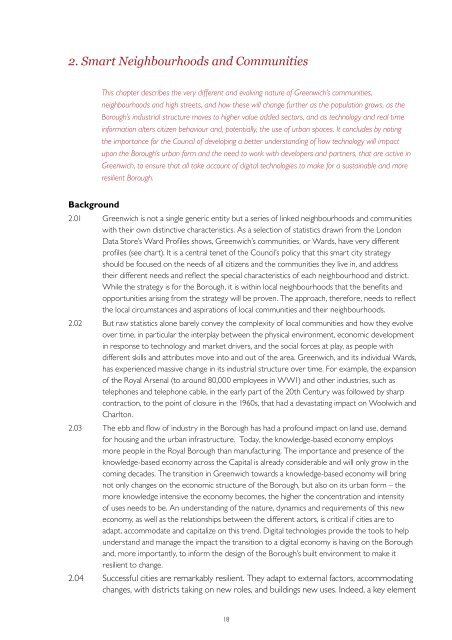Greenwich smart city strategy
You also want an ePaper? Increase the reach of your titles
YUMPU automatically turns print PDFs into web optimized ePapers that Google loves.
2. Smart Neighbourhoods and Communities<br />
This chapter describes the very different and evolving nature of <strong>Greenwich</strong>’s communities,<br />
neighbourhoods and high streets, and how these will change further as the population grows, as the<br />
Borough’s industrial structure moves to higher value added sectors, and as technology and real time<br />
information alters citizen behaviour and, potentially, the use of urban spaces. It concludes by noting<br />
the importance for the Council of developing a better understanding of how technology will impact<br />
upon the Borough’s urban form and the need to work with developers and partners, that are active in<br />
<strong>Greenwich</strong>, to ensure that all take account of digital technologies to make for a sustainable and more<br />
resilient Borough.<br />
Background<br />
2.01 <strong>Greenwich</strong> is not a single generic entity but a series of linked neighbourhoods and communities<br />
with their own distinctive characteristics. As a selection of statistics drawn from the London<br />
Data Store’s Ward Profiles shows, <strong>Greenwich</strong>’s communities, or Wards, have very different<br />
profiles (see chart). It is a central tenet of the Council’s policy that this <strong>smart</strong> <strong>city</strong> <strong>strategy</strong><br />
should be focused on the needs of all citizens and the communities they live in, and address<br />
their different needs and reflect the special characteristics of each neighbourhood and district.<br />
While the <strong>strategy</strong> is for the Borough, it is within local neighbourhoods that the benefits and<br />
opportunities arising from the <strong>strategy</strong> will be proven. The approach, therefore, needs to reflect<br />
the local circumstances and aspirations of local communities and their neighbourhoods.<br />
2.02 But raw statistics alone barely convey the complexity of local communities and how they evolve<br />
over time, in particular the interplay between the physical environment, economic development<br />
in response to technology and market drivers, and the social forces at play, as people with<br />
different skills and attributes move into and out of the area. <strong>Greenwich</strong>, and its individual Wards,<br />
has experienced massive change in its industrial structure over time. For example, the expansion<br />
of the Royal Arsenal (to around 80,000 employees in WW1) and other industries, such as<br />
telephones and telephone cable, in the early part of the 20th Century was followed by sharp<br />
contraction, to the point of closure in the 1960s, that had a devastating impact on Woolwich and<br />
Charlton.<br />
2.03 The ebb and flow of industry in the Borough has had a profound impact on land use, demand<br />
for housing and the urban infrastructure. Today, the knowledge-based economy employs<br />
more people in the Royal Borough than manufacturing. The importance and presence of the<br />
knowledge-based economy across the Capital is already considerable and will only grow in the<br />
coming decades. The transition in <strong>Greenwich</strong> towards a knowledge-based economy will bring<br />
not only changes on the economic structure of the Borough, but also on its urban form – the<br />
more knowledge intensive the economy becomes, the higher the concentration and intensity<br />
of uses needs to be. An understanding of the nature, dynamics and requirements of this new<br />
economy, as well as the relationships between the different actors, is critical if cities are to<br />
adapt, accommodate and capitalize on this trend. Digital technologies provide the tools to help<br />
understand and manage the impact the transition to a digital economy is having on the Borough<br />
and, more importantly, to inform the design of the Borough’s built environment to make it<br />
resilient to change.<br />
2.04 Successful cities are remarkably resilient. They adapt to external factors, accommodating<br />
changes, with districts taking on new roles, and buildings new uses. Indeed, a key element<br />
18


